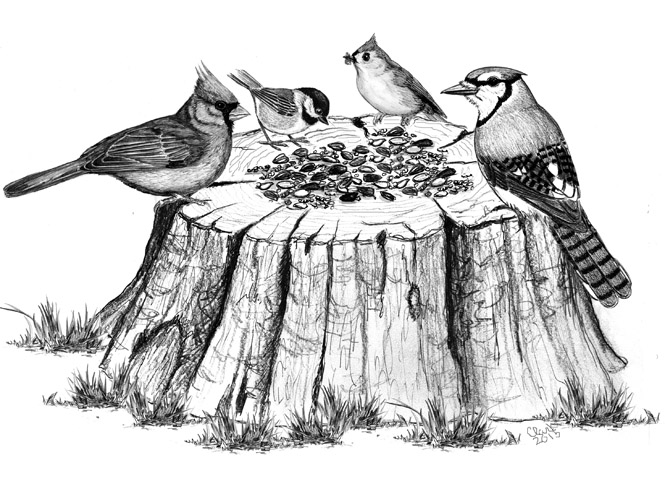
Dear Bird Folks,
I’ve read in your past columns that you feel sunflower is the best seed to offer birds. You also claim that using mixed birdseed is wasteful. But don’t some birds, such as sparrows and juncos, prefer other seeds besides sunflower? Wouldn’t using a mixture be better for these birds?
– John, Fairhaven, MA
No, no, no, John,
A thousand times no. I do not think it would be better to use mixed birdseed and I never will. I might be the only person in the world who continues to feel this way, but it doesn’t mean I’m wrong…just stubborn. I’m a little like boring old Al Gore, who for years preached his concern about climate change, only to be largely ignored. Well, guess what. It turns out Al was on to something and people are starting to see his ideas differently (even though he is still boring). Meanwhile, I keep waiting for the world to agree with me about not using mixed birdseed, but I have a feeling global warming will be solved long before that ever happens.
During my college days I worked at a place called “Spag’s,” the iconic discount store in Central Massachusetts. Occasionally, I would help unload the birdseed trucks, all the while thinking: “Man, this would be a dream job.” Okay, I never thought that, but once in a while I would take some seed home and use it in my feeder. Back then my birdfeeder was nothing but a tree stump with seed sprinkled on it. Feeding birds off a stump might have been a little primitive, but it gave me early insight into bird feeding preferences. The mixed birdseed that I took home from Spag’s would attract lots of birds, but after a few hours the birds disappeared and would not return. I’d go out and check the stump and it was still loaded with plenty of seed, which included cracked corn, white millet, red millet and milo (whatever that is). The only ingredient missing from the mix was the sunflower seed. This pattern repeated over and over until it hit me – ninety percent of what I was paying for was not being eaten. The only seed the birds wanted was sunflower. Ten years later, when I opened my own bird watching specialty store, I was eager to tell my customers about my big discovery. I felt certain that once I told everyone that sunflower seed was the only way to go, they’d take my advice and never ask about mixed seed again. Nope. Thirty-two years later, they are still asking.
Customers regularly enter my shop and ask for a bag of “general mix.” This is when I offer my standard joke and say, “Wasn’t General Mix killed in the Civil War?” (A joke that has never once gotten a laugh, ever.) The confused customer then repeats the need for mixed seed and to emphasize the point will start moving his or her hands in a rotating, mixing motion, looking like a basketball referee signaling a traveling violation. Depending on how tired I am on a particular day, I’ll either explain my sunflower-only theory or just hand over a bag of mixed seed and be done with it. (I’m glad Al Gore didn’t give up as easily as I sometimes do.) The next question is: If mixed seed is so bad, why do companies sell it? To make money, of course, that’s why. Mixed seed comes in all kinds of fancy packaging with creative titles and exorbitant prices, and for some reason the public can’t resist it. One of the most expensive mixtures on the market contains dried fruit. While some birds (mockingbirds, robins) eat fresh fruit, most typical “feeder birds” do not. Yet, many consumers are convinced otherwise. As an experiment, I took home a bag of this fruit mixture (which is triple the cost of other seeds) and put it in a new tray feeder (the 2015 version of my old stump) and watched for the results. The birds came and quickly ate all the sunflower seed that was also in the mixture and left the fruit. Not wanting to be too quick to judge, I refilled the feeder and once again the sunflower was eaten and the dried fruit remained. I even let the fruit sit in the feeder all by itself for over a week, but never had a single taker. Finally, I took the feeder into the house, rinsed off the fruit and saved it to be used in our annual Christmas fruitcake. (Let me know you’d like a slice.)
If you only have one birdfeeder in your yard, my advice is to fill it with 100% sunflower seeds. Here in the Northeast sunflower will get you the greatest variety of birds, including cardinals, chickadees, finches, titmice and nuthatches. If you own more than one feeder and want to experiment with other seeds (corn, millet, safflower, nuts or even dried fruit, go ahead. There is nothing wrong with offering different seeds. Just don’t mix them together or you will never know which seeds your birds are eating and which they are tossing onto the ground (for the nighttime rodents to clean up).
Yes, John, sparrows and juncos do like millet, but you should offer it separately and not mixed in with other ingredients. You can’t fool birds into eating food they don’t want, just like you can’t trick kids into eating broccoli by covering it with mashed potatoes. One way you can prove my theory is to put assorted seeds in a tray feeder (or stump) and then evaluate which seeds are being eaten and which are being ignored. Hey, you could be an official birdseed scientist and if you want to look cool you could even wear a white lab coat and carry a clipboard. (FYI: By looking “cool,” l really mean nerdy. But I’ll bet Al Gore would be impressed.)